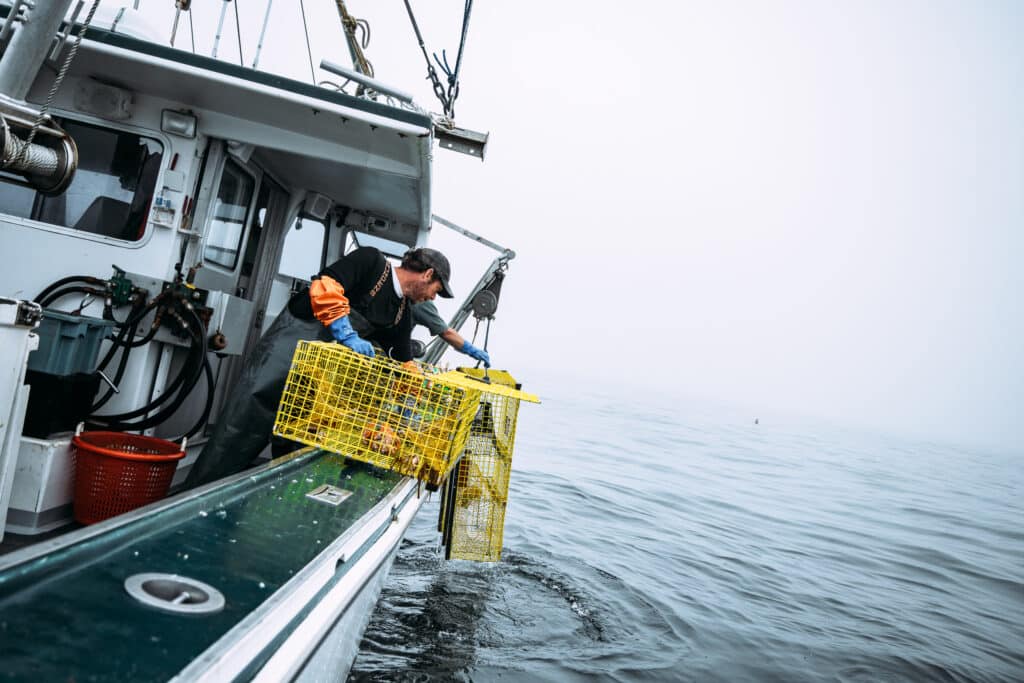Mason’s Famous Lobster Rolls, famed for its mouth-watering lobster rolls and lobster bisque, believes in the motto “good food comes from good practices.” By teaming up with Maine fishermen, the eatery ensures every lobster on the menu has been sourced responsibly, safeguarding the ocean’s bounty for future generations.
The Maine fishermen partners adhere strictly to environmentally friendly fishing practices to ensure that lobster populations remain healthy and vibrant, and that their ecosystems are not disturbed. Moreover, these fishermen are part of a community that has been sustainably harvesting lobsters for generations, making them true stewards of the ocean.
Here are some of the most critical sustainable lobster sourcing practices:
- Trap Limits: One of the most common methods for capturing lobsters is using traps. To prevent overfishing, strict limits are often imposed on the number of traps a fisherman or a fishing vessel can use.
- Size Restrictions: Lobsters that are too small (juveniles) or too large (breeding females) are usually returned to the ocean to sustain the population. The minimum and maximum size limits help ensure that the breeding population is maintained.
- Seasonal Fishing: Fishing seasons are set to avoid critical periods of the lobsters’ lifecycle, such as breeding and moulting seasons, to ensure that the population has the best chance to reproduce and grow.
- V-notching: This is a conservation practice where a notch is cut into the tail fin of a female lobster who carries eggs. This mark signals other fishermen that the lobster is a known breeder and should be returned to the sea if caught.
- Escape Vents in Traps: Traps are designed with escape vents that allow undersized lobsters to escape, ensuring only adult lobsters are caught.
- Biodegradable Panels on Traps: These allow trapped lobsters to escape if the trap is lost at sea or not recovered by the fisherman, preventing ‘ghost fishing’.
“We believe in serving not just great food, but food that tells a story of sustainability,” says [Dan Beck/ franchise founder and CEO]. “By partnering with these fishermen, we’re not only supporting local economies but also ensuring the longevity of the lobster industry.”
Customers visiting Mason’s Famous Lobster Rolls on National Lobster Day can expect an array of sustainable lobster rolls, prepared in simple recipes with no distractions to the Maine lobster. The eatery plans to celebrate the day with a special promotion for everyone to try the sweet, delicate flavor of sustainably-sourced lobster.
In addition to serving sustainable seafood, the restaurant is committed to offering a taste of luxury without the pretension. Beck wanted to create a space where guests could enjoy a well-deserved treat without feeling intimidated. From the friendly staff to the carefully curated menu, every aspect of the dining experience reflected Beck’s commitment to providing an exceptional treat for every walk of life.
This National Lobster Day, Mason’s Famous Lobster Rolls invites you to join them in celebrating the fruits of the sea responsibly. By dining at this eatery, customers can enjoy a delicious meal, confident in the knowledge that their choices are supporting a healthier ocean and a thriving local economy. It’s a seafood dining experience that satisfies both your taste buds and your conscience.
Appendix: Sustainable Practices
Sustainable lobster sourcing practices are designed to ensure that lobster populations remain healthy and vibrant, and that their ecosystems are not disturbed. Here are some of the most critical sustainable lobster sourcing practices:
Trap Limits: One of the most common methods for capturing lobsters is using traps. To prevent overfishing, strict limits are often imposed on the number of traps a fisherman or a fishing vessel can use.
Size Restrictions: Lobsters that are too small (juveniles) or too large (breeding females) are usually returned to the ocean to sustain the population. The minimum and maximum size limits help ensure that the breeding population is maintained.
Seasonal Fishing: Fishing seasons are set to avoid critical periods of the lobsters’ lifecycle, such as breeding and moulting seasons, to ensure that the population has the best chance to reproduce and grow.
V-notching: This is a conservation practice where a notch is cut into the tail fin of a female lobster who carries eggs. This mark signals other fishermen that the lobster is a known breeder and should be returned to the sea if caught.
Escape Vents in Traps: Traps are designed with escape vents that allow undersized lobsters to escape, ensuring only adult lobsters are caught.
Biodegradable Panels on Traps: These allow trapped lobsters to escape if the trap is lost at sea or not recovered by the fisherman, preventing ‘ghost fishing’.
Limiting the Fishing Effort: This could involve restricting the number of fishing licenses issued, or the number of fishing days, to control the total amount of lobster harvested.
Rotational Fishing Areas: Some regions may temporarily close off certain areas to lobster fishing to allow for population recovery, then rotate these areas over time.
Strict Enforcement: Regular monitoring and law enforcement are necessary to ensure all the rules and regulations are followed.
These sustainable practices, when followed correctly, help to ensure that lobster populations remain healthy, and that lobster fishing can continue for generations to come.
